Academic Performance Project 2: Comprehensive Child Labour Case Study
VerifiedAdded on 2022/11/28
|7
|2009
|104
Project
AI Summary
This project is a comprehensive case study on child labour, exploring its multifaceted dimensions. The assignment begins with a reflective section, evaluating the student's learning experience from lectures, focusing on skills like listening, critical thinking, and problem-solving. The main body delves into the core issue of child labour, defining it as the exploitation of children that deprives them of education and harms their well-being. It traces the historical context of child labour from pre-industrial societies to the industrial revolution and the 21st century, highlighting the roles of poverty, lack of education, and cultural beliefs as key drivers. The project also examines the microeconomic factors that contribute to child labour, such as supply and demand dynamics, and the impact of inflexible labour markets. Furthermore, it provides an overview of the laws in the UK that protect children from exploitation, such as the Employment of Women, Children and Young Persons Act 1920 and the Offices, Shops and Railway Premises Act 1963. The project concludes by emphasizing the need for awareness, stringent laws, effective implementation, and educational initiatives to reduce child labour. The student used references from journals and books to support the research.
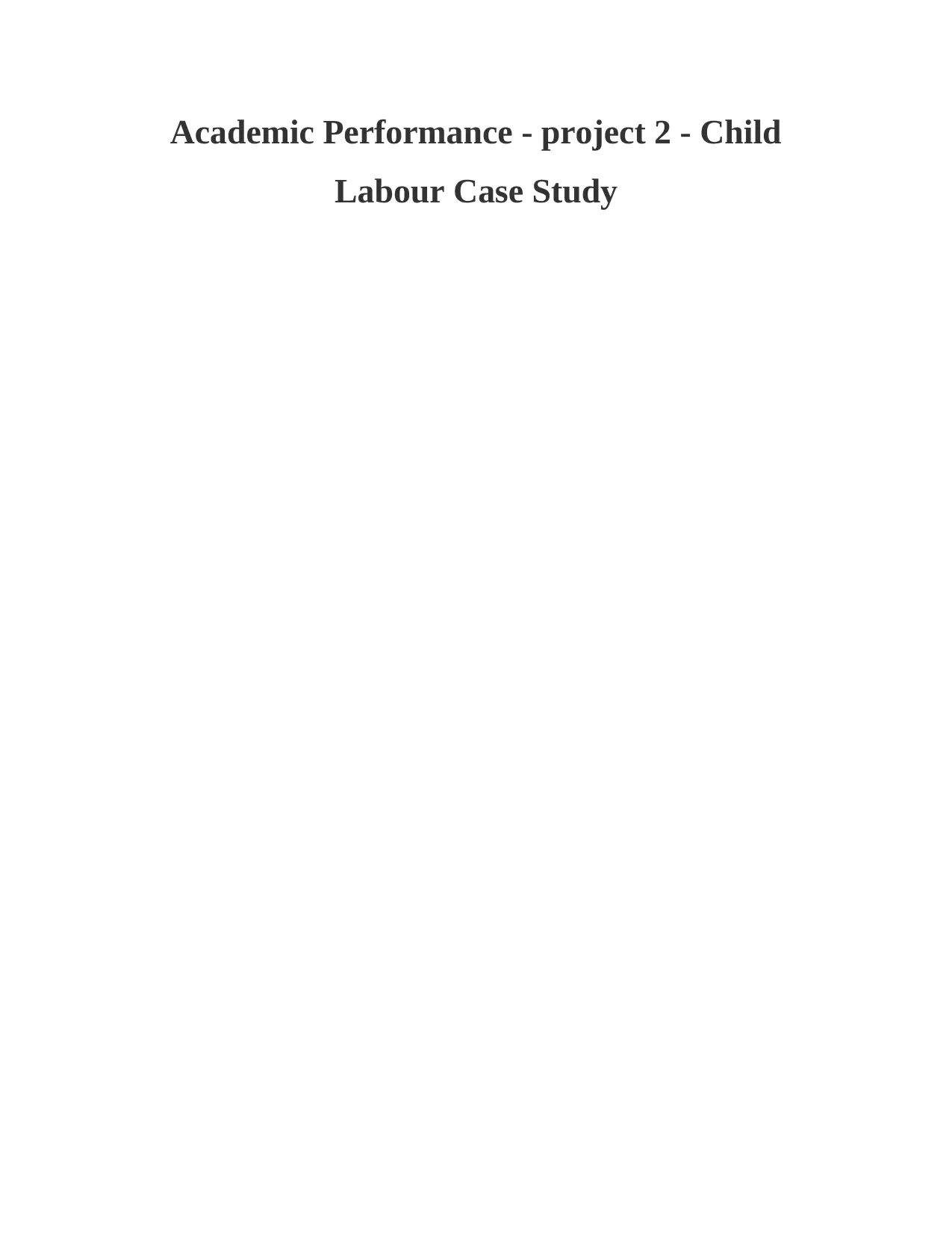
Academic Performance - project 2 - Child
Labour Case Study
Labour Case Study
Paraphrase This Document
Need a fresh take? Get an instant paraphrase of this document with our AI Paraphraser
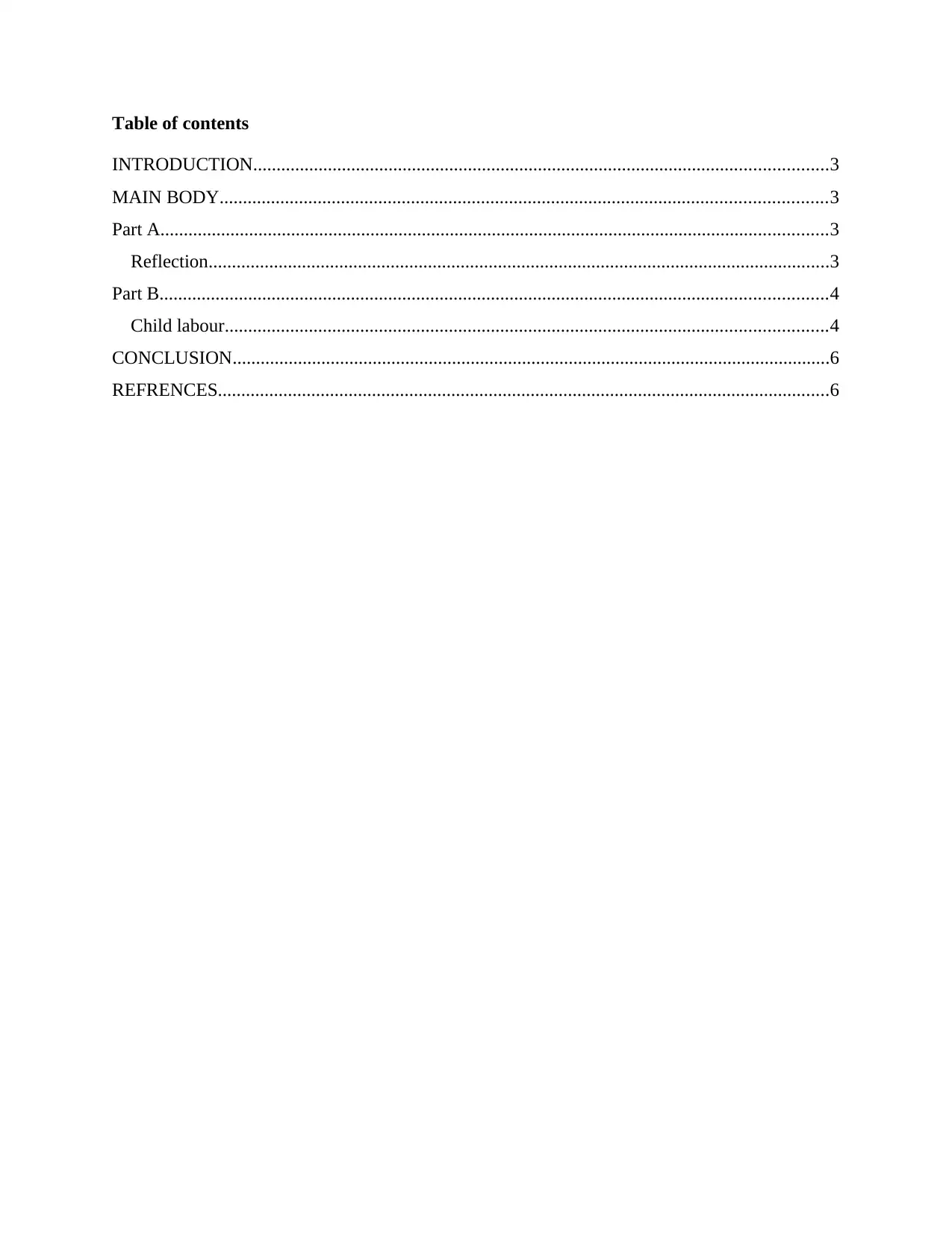
Table of contents
INTRODUCTION...........................................................................................................................3
MAIN BODY..................................................................................................................................3
Part A...............................................................................................................................................3
Reflection.....................................................................................................................................3
Part B...............................................................................................................................................4
Child labour.................................................................................................................................4
CONCLUSION................................................................................................................................6
REFRENCES...................................................................................................................................6
INTRODUCTION...........................................................................................................................3
MAIN BODY..................................................................................................................................3
Part A...............................................................................................................................................3
Reflection.....................................................................................................................................3
Part B...............................................................................................................................................4
Child labour.................................................................................................................................4
CONCLUSION................................................................................................................................6
REFRENCES...................................................................................................................................6
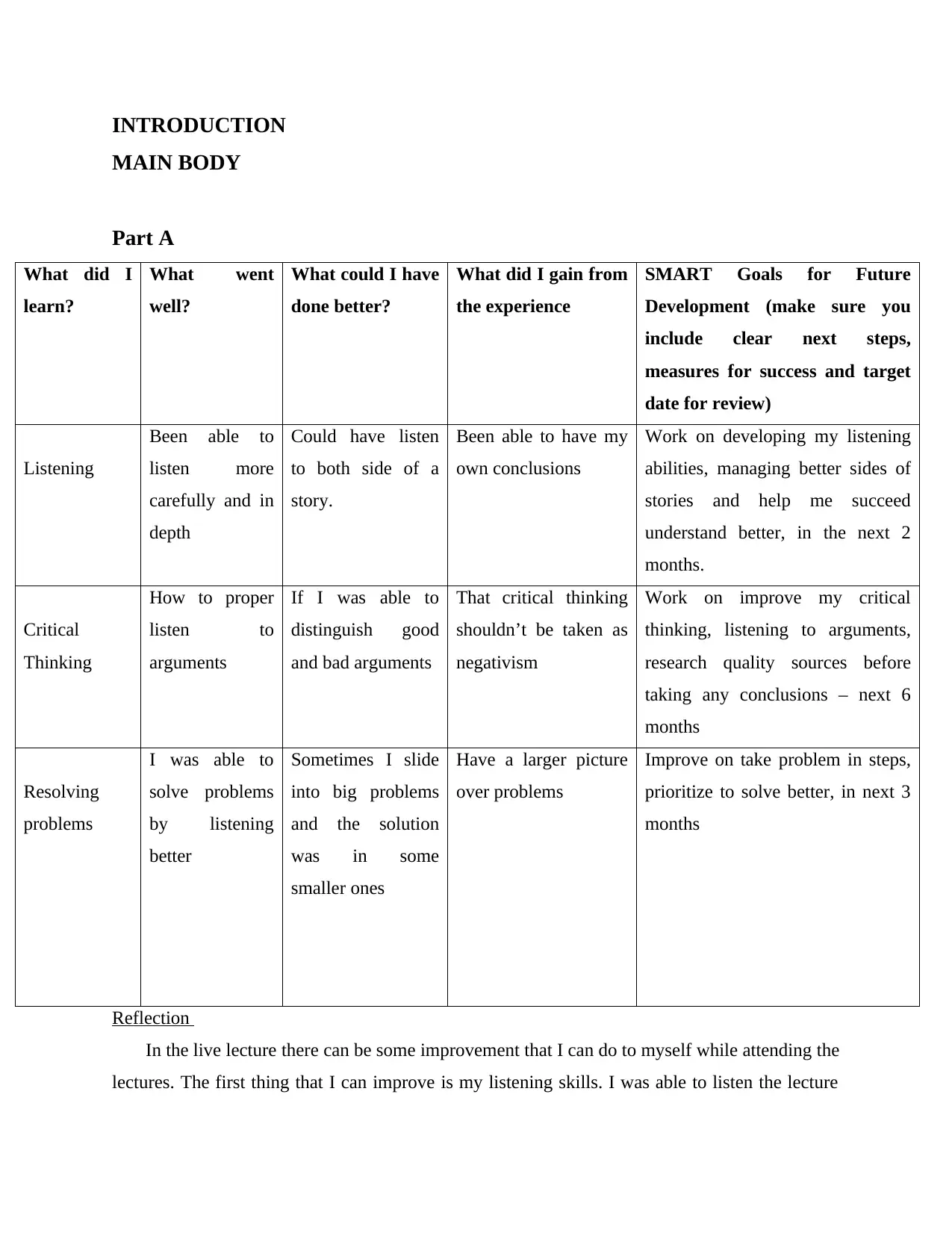
INTRODUCTION
MAIN BODY
Part A
What did I
learn?
What went
well?
What could I have
done better?
What did I gain from
the experience
SMART Goals for Future
Development (make sure you
include clear next steps,
measures for success and target
date for review)
Listening
Been able to
listen more
carefully and in
depth
Could have listen
to both side of a
story.
Been able to have my
own conclusions
Work on developing my listening
abilities, managing better sides of
stories and help me succeed
understand better, in the next 2
months.
Critical
Thinking
How to proper
listen to
arguments
If I was able to
distinguish good
and bad arguments
That critical thinking
shouldn’t be taken as
negativism
Work on improve my critical
thinking, listening to arguments,
research quality sources before
taking any conclusions – next 6
months
Resolving
problems
I was able to
solve problems
by listening
better
Sometimes I slide
into big problems
and the solution
was in some
smaller ones
Have a larger picture
over problems
Improve on take problem in steps,
prioritize to solve better, in next 3
months
Reflection
In the live lecture there can be some improvement that I can do to myself while attending the
lectures. The first thing that I can improve is my listening skills. I was able to listen the lecture
MAIN BODY
Part A
What did I
learn?
What went
well?
What could I have
done better?
What did I gain from
the experience
SMART Goals for Future
Development (make sure you
include clear next steps,
measures for success and target
date for review)
Listening
Been able to
listen more
carefully and in
depth
Could have listen
to both side of a
story.
Been able to have my
own conclusions
Work on developing my listening
abilities, managing better sides of
stories and help me succeed
understand better, in the next 2
months.
Critical
Thinking
How to proper
listen to
arguments
If I was able to
distinguish good
and bad arguments
That critical thinking
shouldn’t be taken as
negativism
Work on improve my critical
thinking, listening to arguments,
research quality sources before
taking any conclusions – next 6
months
Resolving
problems
I was able to
solve problems
by listening
better
Sometimes I slide
into big problems
and the solution
was in some
smaller ones
Have a larger picture
over problems
Improve on take problem in steps,
prioritize to solve better, in next 3
months
Reflection
In the live lecture there can be some improvement that I can do to myself while attending the
lectures. The first thing that I can improve is my listening skills. I was able to listen the lecture
⊘ This is a preview!⊘
Do you want full access?
Subscribe today to unlock all pages.

Trusted by 1+ million students worldwide
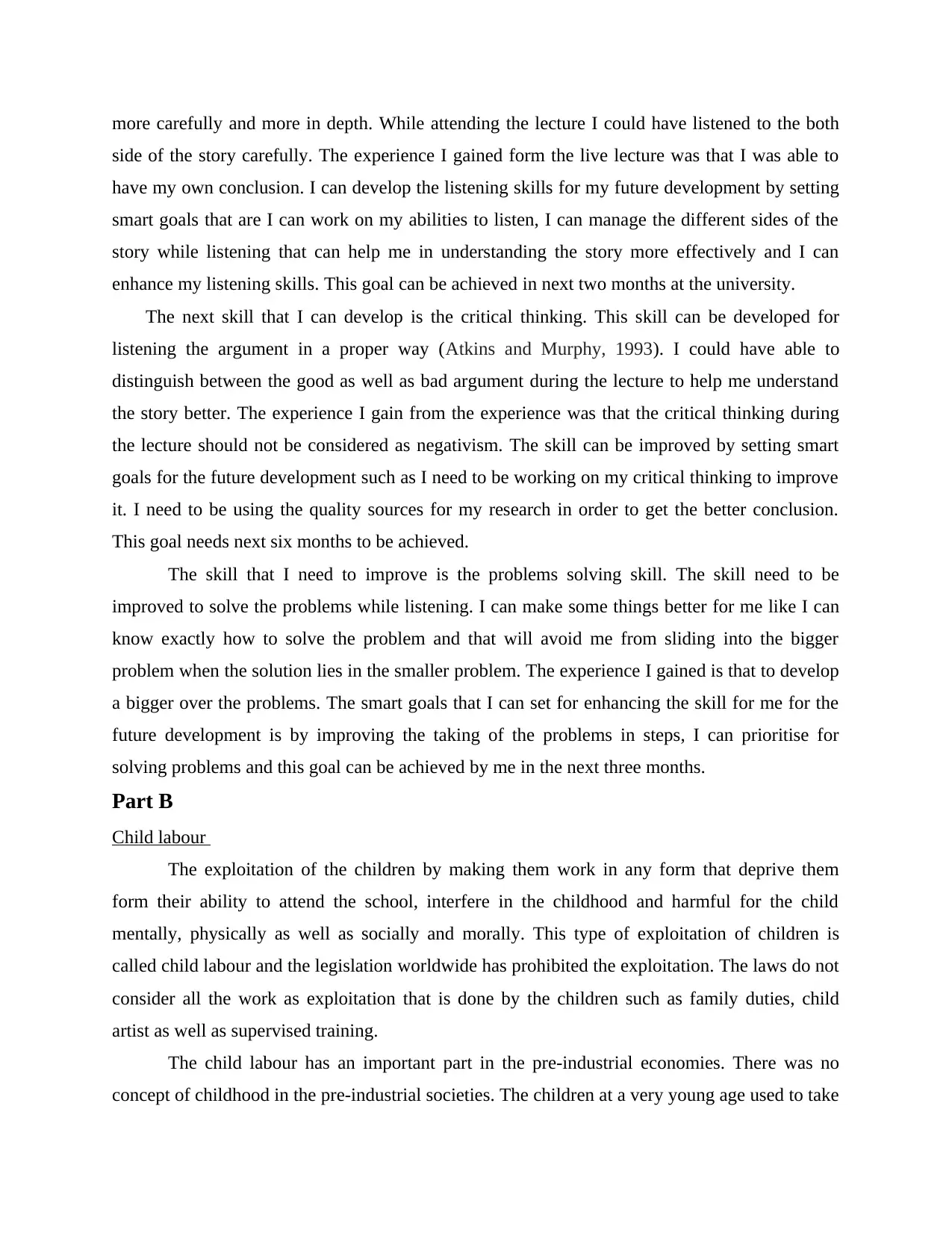
more carefully and more in depth. While attending the lecture I could have listened to the both
side of the story carefully. The experience I gained form the live lecture was that I was able to
have my own conclusion. I can develop the listening skills for my future development by setting
smart goals that are I can work on my abilities to listen, I can manage the different sides of the
story while listening that can help me in understanding the story more effectively and I can
enhance my listening skills. This goal can be achieved in next two months at the university.
The next skill that I can develop is the critical thinking. This skill can be developed for
listening the argument in a proper way (Atkins and Murphy, 1993). I could have able to
distinguish between the good as well as bad argument during the lecture to help me understand
the story better. The experience I gain from the experience was that the critical thinking during
the lecture should not be considered as negativism. The skill can be improved by setting smart
goals for the future development such as I need to be working on my critical thinking to improve
it. I need to be using the quality sources for my research in order to get the better conclusion.
This goal needs next six months to be achieved.
The skill that I need to improve is the problems solving skill. The skill need to be
improved to solve the problems while listening. I can make some things better for me like I can
know exactly how to solve the problem and that will avoid me from sliding into the bigger
problem when the solution lies in the smaller problem. The experience I gained is that to develop
a bigger over the problems. The smart goals that I can set for enhancing the skill for me for the
future development is by improving the taking of the problems in steps, I can prioritise for
solving problems and this goal can be achieved by me in the next three months.
Part B
Child labour
The exploitation of the children by making them work in any form that deprive them
form their ability to attend the school, interfere in the childhood and harmful for the child
mentally, physically as well as socially and morally. This type of exploitation of children is
called child labour and the legislation worldwide has prohibited the exploitation. The laws do not
consider all the work as exploitation that is done by the children such as family duties, child
artist as well as supervised training.
The child labour has an important part in the pre-industrial economies. There was no
concept of childhood in the pre-industrial societies. The children at a very young age used to take
side of the story carefully. The experience I gained form the live lecture was that I was able to
have my own conclusion. I can develop the listening skills for my future development by setting
smart goals that are I can work on my abilities to listen, I can manage the different sides of the
story while listening that can help me in understanding the story more effectively and I can
enhance my listening skills. This goal can be achieved in next two months at the university.
The next skill that I can develop is the critical thinking. This skill can be developed for
listening the argument in a proper way (Atkins and Murphy, 1993). I could have able to
distinguish between the good as well as bad argument during the lecture to help me understand
the story better. The experience I gain from the experience was that the critical thinking during
the lecture should not be considered as negativism. The skill can be improved by setting smart
goals for the future development such as I need to be working on my critical thinking to improve
it. I need to be using the quality sources for my research in order to get the better conclusion.
This goal needs next six months to be achieved.
The skill that I need to improve is the problems solving skill. The skill need to be
improved to solve the problems while listening. I can make some things better for me like I can
know exactly how to solve the problem and that will avoid me from sliding into the bigger
problem when the solution lies in the smaller problem. The experience I gained is that to develop
a bigger over the problems. The smart goals that I can set for enhancing the skill for me for the
future development is by improving the taking of the problems in steps, I can prioritise for
solving problems and this goal can be achieved by me in the next three months.
Part B
Child labour
The exploitation of the children by making them work in any form that deprive them
form their ability to attend the school, interfere in the childhood and harmful for the child
mentally, physically as well as socially and morally. This type of exploitation of children is
called child labour and the legislation worldwide has prohibited the exploitation. The laws do not
consider all the work as exploitation that is done by the children such as family duties, child
artist as well as supervised training.
The child labour has an important part in the pre-industrial economies. There was no
concept of childhood in the pre-industrial societies. The children at a very young age used to take
Paraphrase This Document
Need a fresh take? Get an instant paraphrase of this document with our AI Paraphraser
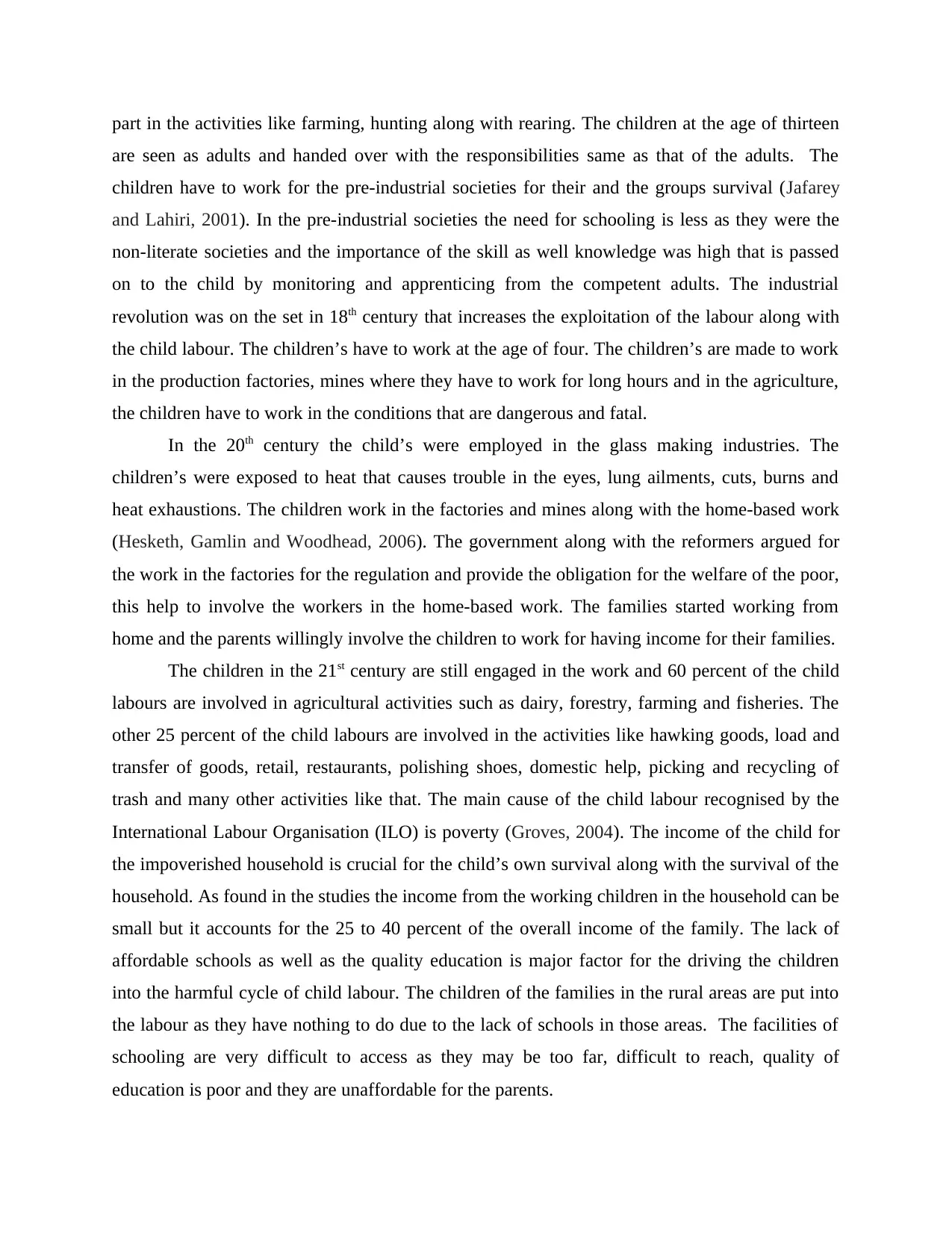
part in the activities like farming, hunting along with rearing. The children at the age of thirteen
are seen as adults and handed over with the responsibilities same as that of the adults. The
children have to work for the pre-industrial societies for their and the groups survival (Jafarey
and Lahiri, 2001). In the pre-industrial societies the need for schooling is less as they were the
non-literate societies and the importance of the skill as well knowledge was high that is passed
on to the child by monitoring and apprenticing from the competent adults. The industrial
revolution was on the set in 18th century that increases the exploitation of the labour along with
the child labour. The children’s have to work at the age of four. The children’s are made to work
in the production factories, mines where they have to work for long hours and in the agriculture,
the children have to work in the conditions that are dangerous and fatal.
In the 20th century the child’s were employed in the glass making industries. The
children’s were exposed to heat that causes trouble in the eyes, lung ailments, cuts, burns and
heat exhaustions. The children work in the factories and mines along with the home-based work
(Hesketh, Gamlin and Woodhead, 2006). The government along with the reformers argued for
the work in the factories for the regulation and provide the obligation for the welfare of the poor,
this help to involve the workers in the home-based work. The families started working from
home and the parents willingly involve the children to work for having income for their families.
The children in the 21st century are still engaged in the work and 60 percent of the child
labours are involved in agricultural activities such as dairy, forestry, farming and fisheries. The
other 25 percent of the child labours are involved in the activities like hawking goods, load and
transfer of goods, retail, restaurants, polishing shoes, domestic help, picking and recycling of
trash and many other activities like that. The main cause of the child labour recognised by the
International Labour Organisation (ILO) is poverty (Groves, 2004). The income of the child for
the impoverished household is crucial for the child’s own survival along with the survival of the
household. As found in the studies the income from the working children in the household can be
small but it accounts for the 25 to 40 percent of the overall income of the family. The lack of
affordable schools as well as the quality education is major factor for the driving the children
into the harmful cycle of child labour. The children of the families in the rural areas are put into
the labour as they have nothing to do due to the lack of schools in those areas. The facilities of
schooling are very difficult to access as they may be too far, difficult to reach, quality of
education is poor and they are unaffordable for the parents.
are seen as adults and handed over with the responsibilities same as that of the adults. The
children have to work for the pre-industrial societies for their and the groups survival (Jafarey
and Lahiri, 2001). In the pre-industrial societies the need for schooling is less as they were the
non-literate societies and the importance of the skill as well knowledge was high that is passed
on to the child by monitoring and apprenticing from the competent adults. The industrial
revolution was on the set in 18th century that increases the exploitation of the labour along with
the child labour. The children’s have to work at the age of four. The children’s are made to work
in the production factories, mines where they have to work for long hours and in the agriculture,
the children have to work in the conditions that are dangerous and fatal.
In the 20th century the child’s were employed in the glass making industries. The
children’s were exposed to heat that causes trouble in the eyes, lung ailments, cuts, burns and
heat exhaustions. The children work in the factories and mines along with the home-based work
(Hesketh, Gamlin and Woodhead, 2006). The government along with the reformers argued for
the work in the factories for the regulation and provide the obligation for the welfare of the poor,
this help to involve the workers in the home-based work. The families started working from
home and the parents willingly involve the children to work for having income for their families.
The children in the 21st century are still engaged in the work and 60 percent of the child
labours are involved in agricultural activities such as dairy, forestry, farming and fisheries. The
other 25 percent of the child labours are involved in the activities like hawking goods, load and
transfer of goods, retail, restaurants, polishing shoes, domestic help, picking and recycling of
trash and many other activities like that. The main cause of the child labour recognised by the
International Labour Organisation (ILO) is poverty (Groves, 2004). The income of the child for
the impoverished household is crucial for the child’s own survival along with the survival of the
household. As found in the studies the income from the working children in the household can be
small but it accounts for the 25 to 40 percent of the overall income of the family. The lack of
affordable schools as well as the quality education is major factor for the driving the children
into the harmful cycle of child labour. The children of the families in the rural areas are put into
the labour as they have nothing to do due to the lack of schools in those areas. The facilities of
schooling are very difficult to access as they may be too far, difficult to reach, quality of
education is poor and they are unaffordable for the parents.
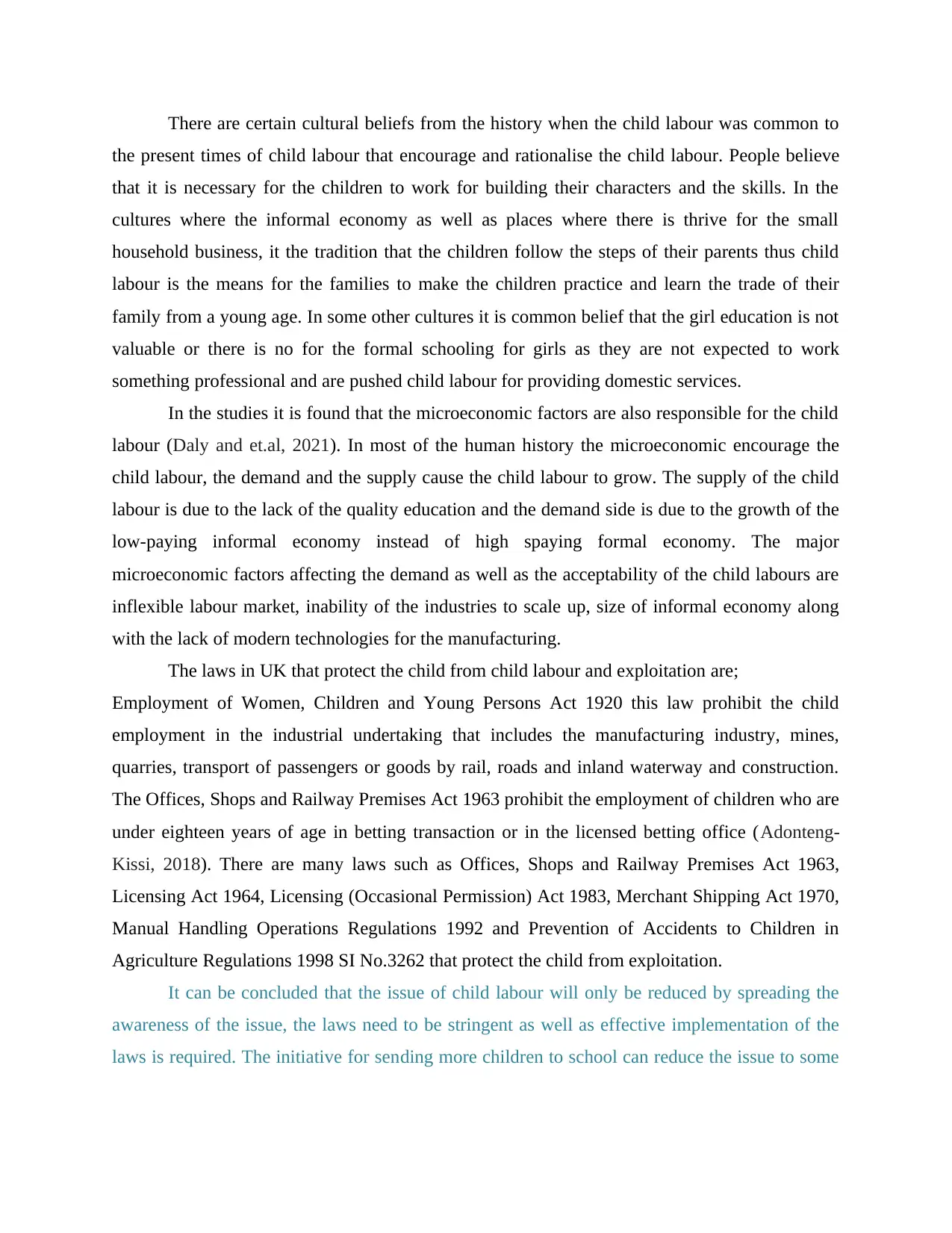
There are certain cultural beliefs from the history when the child labour was common to
the present times of child labour that encourage and rationalise the child labour. People believe
that it is necessary for the children to work for building their characters and the skills. In the
cultures where the informal economy as well as places where there is thrive for the small
household business, it the tradition that the children follow the steps of their parents thus child
labour is the means for the families to make the children practice and learn the trade of their
family from a young age. In some other cultures it is common belief that the girl education is not
valuable or there is no for the formal schooling for girls as they are not expected to work
something professional and are pushed child labour for providing domestic services.
In the studies it is found that the microeconomic factors are also responsible for the child
labour (Daly and et.al, 2021). In most of the human history the microeconomic encourage the
child labour, the demand and the supply cause the child labour to grow. The supply of the child
labour is due to the lack of the quality education and the demand side is due to the growth of the
low-paying informal economy instead of high spaying formal economy. The major
microeconomic factors affecting the demand as well as the acceptability of the child labours are
inflexible labour market, inability of the industries to scale up, size of informal economy along
with the lack of modern technologies for the manufacturing.
The laws in UK that protect the child from child labour and exploitation are;
Employment of Women, Children and Young Persons Act 1920 this law prohibit the child
employment in the industrial undertaking that includes the manufacturing industry, mines,
quarries, transport of passengers or goods by rail, roads and inland waterway and construction.
The Offices, Shops and Railway Premises Act 1963 prohibit the employment of children who are
under eighteen years of age in betting transaction or in the licensed betting office (Adonteng-
Kissi, 2018). There are many laws such as Offices, Shops and Railway Premises Act 1963,
Licensing Act 1964, Licensing (Occasional Permission) Act 1983, Merchant Shipping Act 1970,
Manual Handling Operations Regulations 1992 and Prevention of Accidents to Children in
Agriculture Regulations 1998 SI No.3262 that protect the child from exploitation.
It can be concluded that the issue of child labour will only be reduced by spreading the
awareness of the issue, the laws need to be stringent as well as effective implementation of the
laws is required. The initiative for sending more children to school can reduce the issue to some
the present times of child labour that encourage and rationalise the child labour. People believe
that it is necessary for the children to work for building their characters and the skills. In the
cultures where the informal economy as well as places where there is thrive for the small
household business, it the tradition that the children follow the steps of their parents thus child
labour is the means for the families to make the children practice and learn the trade of their
family from a young age. In some other cultures it is common belief that the girl education is not
valuable or there is no for the formal schooling for girls as they are not expected to work
something professional and are pushed child labour for providing domestic services.
In the studies it is found that the microeconomic factors are also responsible for the child
labour (Daly and et.al, 2021). In most of the human history the microeconomic encourage the
child labour, the demand and the supply cause the child labour to grow. The supply of the child
labour is due to the lack of the quality education and the demand side is due to the growth of the
low-paying informal economy instead of high spaying formal economy. The major
microeconomic factors affecting the demand as well as the acceptability of the child labours are
inflexible labour market, inability of the industries to scale up, size of informal economy along
with the lack of modern technologies for the manufacturing.
The laws in UK that protect the child from child labour and exploitation are;
Employment of Women, Children and Young Persons Act 1920 this law prohibit the child
employment in the industrial undertaking that includes the manufacturing industry, mines,
quarries, transport of passengers or goods by rail, roads and inland waterway and construction.
The Offices, Shops and Railway Premises Act 1963 prohibit the employment of children who are
under eighteen years of age in betting transaction or in the licensed betting office (Adonteng-
Kissi, 2018). There are many laws such as Offices, Shops and Railway Premises Act 1963,
Licensing Act 1964, Licensing (Occasional Permission) Act 1983, Merchant Shipping Act 1970,
Manual Handling Operations Regulations 1992 and Prevention of Accidents to Children in
Agriculture Regulations 1998 SI No.3262 that protect the child from exploitation.
It can be concluded that the issue of child labour will only be reduced by spreading the
awareness of the issue, the laws need to be stringent as well as effective implementation of the
laws is required. The initiative for sending more children to school can reduce the issue to some
⊘ This is a preview!⊘
Do you want full access?
Subscribe today to unlock all pages.

Trusted by 1+ million students worldwide
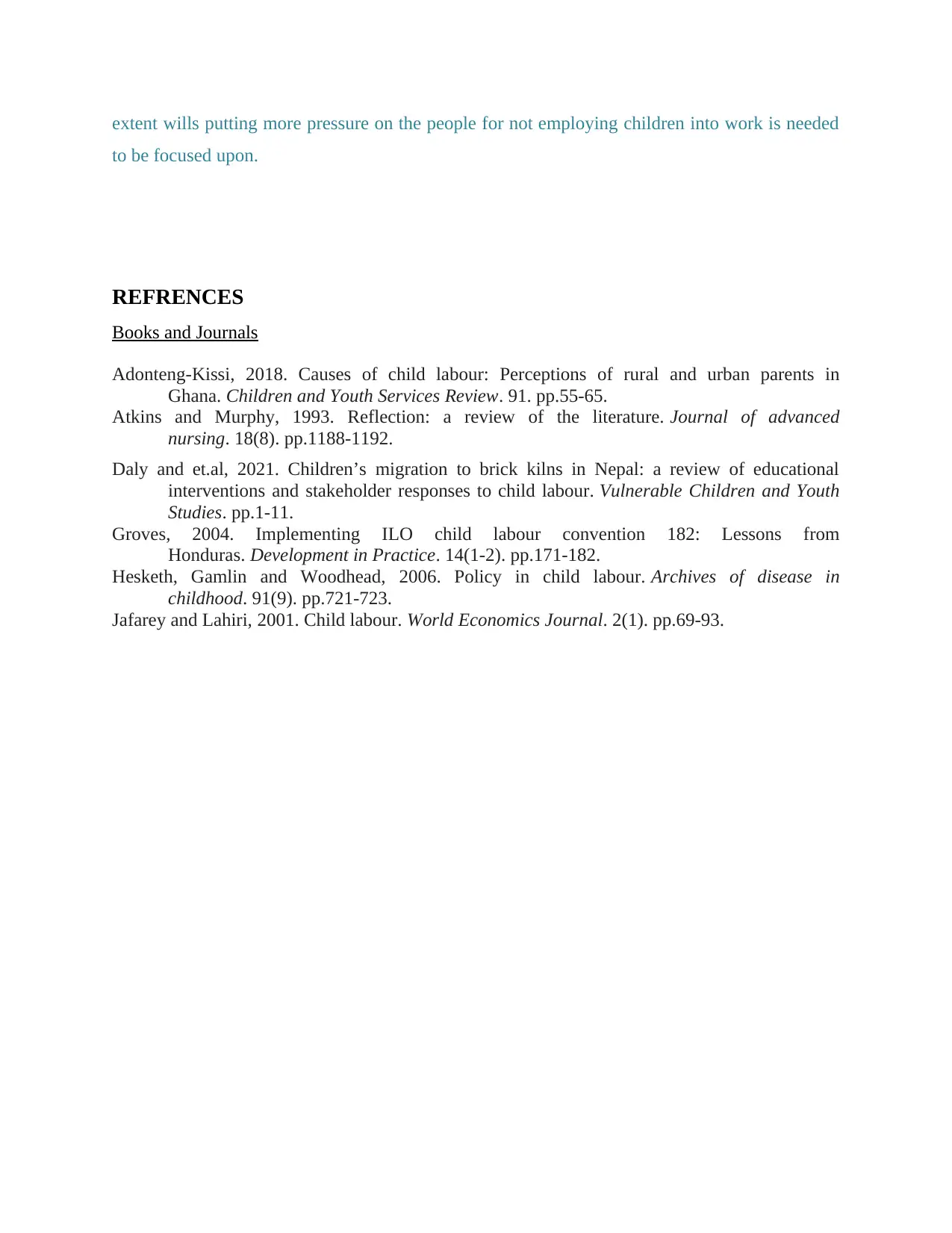
extent wills putting more pressure on the people for not employing children into work is needed
to be focused upon.
REFRENCES
Books and Journals
Adonteng-Kissi, 2018. Causes of child labour: Perceptions of rural and urban parents in
Ghana. Children and Youth Services Review. 91. pp.55-65.
Atkins and Murphy, 1993. Reflection: a review of the literature. Journal of advanced
nursing. 18(8). pp.1188-1192.
Daly and et.al, 2021. Children’s migration to brick kilns in Nepal: a review of educational
interventions and stakeholder responses to child labour. Vulnerable Children and Youth
Studies. pp.1-11.
Groves, 2004. Implementing ILO child labour convention 182: Lessons from
Honduras. Development in Practice. 14(1-2). pp.171-182.
Hesketh, Gamlin and Woodhead, 2006. Policy in child labour. Archives of disease in
childhood. 91(9). pp.721-723.
Jafarey and Lahiri, 2001. Child labour. World Economics Journal. 2(1). pp.69-93.
to be focused upon.
REFRENCES
Books and Journals
Adonteng-Kissi, 2018. Causes of child labour: Perceptions of rural and urban parents in
Ghana. Children and Youth Services Review. 91. pp.55-65.
Atkins and Murphy, 1993. Reflection: a review of the literature. Journal of advanced
nursing. 18(8). pp.1188-1192.
Daly and et.al, 2021. Children’s migration to brick kilns in Nepal: a review of educational
interventions and stakeholder responses to child labour. Vulnerable Children and Youth
Studies. pp.1-11.
Groves, 2004. Implementing ILO child labour convention 182: Lessons from
Honduras. Development in Practice. 14(1-2). pp.171-182.
Hesketh, Gamlin and Woodhead, 2006. Policy in child labour. Archives of disease in
childhood. 91(9). pp.721-723.
Jafarey and Lahiri, 2001. Child labour. World Economics Journal. 2(1). pp.69-93.
1 out of 7
Related Documents
Your All-in-One AI-Powered Toolkit for Academic Success.
+13062052269
info@desklib.com
Available 24*7 on WhatsApp / Email
![[object Object]](/_next/static/media/star-bottom.7253800d.svg)
Unlock your academic potential
Copyright © 2020–2025 A2Z Services. All Rights Reserved. Developed and managed by ZUCOL.





